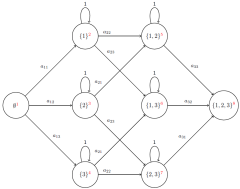 Time and again, there are moments when mathematics just feels magical.
Time and again, there are moments when mathematics just feels magical.
For me, one example for this is given by generating functions (and that is why they can be found on this blog).
Today, I want to talk about another such example: involutions. We will look at how they are used to prove in one sentence that primes of the form can be written as a sum of squares, in the proof of the wonderful Lindström-Gessel-Viennot lemma, and in the proof of Euler’s pentagonal number theorem.
A Beautiful Analytic Combination
 Recently, I was looking for good motivating examples for complex analysis in several variables. There was already a short discussion of this question at MathOverflow. Some further searching led me to the book Analytic Combinatorics in Several Variables by Robin Pemantle and Mark C. Wilson. What is this all about and why did I fall in love immediately?
Recently, I was looking for good motivating examples for complex analysis in several variables. There was already a short discussion of this question at MathOverflow. Some further searching led me to the book Analytic Combinatorics in Several Variables by Robin Pemantle and Mark C. Wilson. What is this all about and why did I fall in love immediately?
The Beats of Bitterns
 In my PhD thesis and in the paper Detecting bird sounds in a complex acoustic environment and application to bioacoustic monitoring, I have proposed a simple yet robust algorithm for automatically detecting calls of the Eurasian bittern in the wild.
In my PhD thesis and in the paper Detecting bird sounds in a complex acoustic environment and application to bioacoustic monitoring, I have proposed a simple yet robust algorithm for automatically detecting calls of the Eurasian bittern in the wild.
The Eurasian bittern is a threatened bird species found in reed beds and other wetland habitats. Its sound is very simple, very deep, and very characteristic. It is pretty similar to what you can produce by blowing over the opening of an empty bottle (use a large one) in regular intervals.
Recently, I have been asked whether I still have the Matlab code for the algorithm. A bit of digging on an external hard drive has shown that I indeed still have it.
How Algebra Sheds Light on Things
 Egbert Brieskorn‘s mathematics books contain a lot more flesh than those structured strictly by definitions, lemmas, and theorems. What might be a hindrance to those looking for a quick grasp of a theory is a treasure trove for others who relish an extra of motivation, history, and examples. Currently, I am reading his book Plane Algebraic Curves (authored together with Horst Knörrer) which, already in the introductory chapter, contains many wonderful examples such as linkages, envelopes, and the Hopf fibration. I will come back to some of these topics in later posts. Today’s post contains a quick glimpse of caustics.
Egbert Brieskorn‘s mathematics books contain a lot more flesh than those structured strictly by definitions, lemmas, and theorems. What might be a hindrance to those looking for a quick grasp of a theory is a treasure trove for others who relish an extra of motivation, history, and examples. Currently, I am reading his book Plane Algebraic Curves (authored together with Horst Knörrer) which, already in the introductory chapter, contains many wonderful examples such as linkages, envelopes, and the Hopf fibration. I will come back to some of these topics in later posts. Today’s post contains a quick glimpse of caustics.
Beautiful Binomials
 While leafing through the book Geometric Trilogy I – An Axiomatic Approach to Geometry, I came across two nice geometric depictions that are probably widely known but which I would love to have seen back in school. The first one is the geometric illustration of the algebraic fact that
While leafing through the book Geometric Trilogy I – An Axiomatic Approach to Geometry, I came across two nice geometric depictions that are probably widely known but which I would love to have seen back in school. The first one is the geometric illustration of the algebraic fact that , the quadratic case of the binomial theorem. This can already be found in Book II of Euclid’s Elements. From this, it is easy to come up with a three dimensional version of the construction giving
. Creating a good picture of this is somewhat tedious so I am very glad that I can use this opportunity to link to a wonderful blog where this and other wonderful mathematical illustrations and animations can be found: Hyrodium’s Graphical MathLand.
Permanent Determinant
 The determinant and the permanent of a matrix are central characters in an endeavour to bring the powerful weapons of modern geometry to a battle in the epic war of computer science: the P vs. NP problem.
The determinant and the permanent of a matrix are central characters in an endeavour to bring the powerful weapons of modern geometry to a battle in the epic war of computer science: the P vs. NP problem.
JM Landsberg has recently written a wonderful introduction to geometric complexity theory which is how the corresponding research field is called. This has inspired me to borrow some of it and write about the permanent and the determinant of a matrix.
Euler and the Kids
 Being on parental leave, somewhat naturally, gave me more time to spend in the kids’ room. After a chance encounter with Mr Pythagoras there some time ago, it was now time for a scheduled meeting with Mr Euler. The configuration in the image to this post is known to young parents as an Oball. To mathematicians, it is known as the truncated icosahedron. An interesting fact is that because it is constructed entirely from pentagons and hexagons, it has to have exactly 12 pentagons. Let’s see how Mr Euler can convince us of this necessity. Continue reading
Being on parental leave, somewhat naturally, gave me more time to spend in the kids’ room. After a chance encounter with Mr Pythagoras there some time ago, it was now time for a scheduled meeting with Mr Euler. The configuration in the image to this post is known to young parents as an Oball. To mathematicians, it is known as the truncated icosahedron. An interesting fact is that because it is constructed entirely from pentagons and hexagons, it has to have exactly 12 pentagons. Let’s see how Mr Euler can convince us of this necessity. Continue reading
Pythagoras and the Kids
 Yesterday, when playing with the kids, I found Mr. Pythagoras unexpectedly in their room. For a fraction of a second, I wondered why the Lego fence would fit perfectly across. Then, I saw that I had produced an instance of the 3-4-5 triangle.
Yesterday, when playing with the kids, I found Mr. Pythagoras unexpectedly in their room. For a fraction of a second, I wondered why the Lego fence would fit perfectly across. Then, I saw that I had produced an instance of the 3-4-5 triangle.
The Mandelbulb
 It seems completely natural that going from 2d to 3d adds a new dimension of awesomeness to fractals. Accordingly, it is quite a shame that until very recently, I was not aware of the magnificent Mandelbulb. If this is a new world for you, too, go and explore the wonders of 3d fractals using tools like Mandelbulb 3d.
It seems completely natural that going from 2d to 3d adds a new dimension of awesomeness to fractals. Accordingly, it is quite a shame that until very recently, I was not aware of the magnificent Mandelbulb. If this is a new world for you, too, go and explore the wonders of 3d fractals using tools like Mandelbulb 3d.
How Hard is Your Maths?
 In Brainiac: Science Abuse, there is a wonderful category called How Hard is Your Thing? (see [1]). Thaila Zucchi makes seemingly hard things undergo some of the ultimate stress tests: Can they stand the heat of thermite? The abrasion of an angle grinder? The impact of a ton of bricks?
In Brainiac: Science Abuse, there is a wonderful category called How Hard is Your Thing? (see [1]). Thaila Zucchi makes seemingly hard things undergo some of the ultimate stress tests: Can they stand the heat of thermite? The abrasion of an angle grinder? The impact of a ton of bricks?
There were several occasions in the history of mathematics when mathematicians had to answer to the question: how hard is your maths?